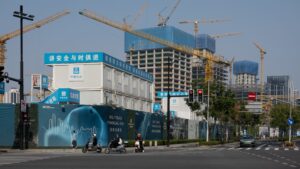Understanding China’s Economic Landscape: A Deep Dive into April’s Data
Welcome to the Extreme Investor Network, where we provide you with cutting-edge insights into global financial markets and economies. Today, we’re unpacking the latest data from China, the world’s second-largest economy, and what it means for investors and businesses alike.
Slowing Retail Sales: A Call for Caution
China’s retail sales growth has shown signs of slowing, rising by just 5.1% year-on-year in April. This figure missed analysts’ expectations of 5.5%, and marks a decline from the 5.9% growth seen in March. Such figures might suggest that consumer confidence is wavering, and businesses should be prepared for a challenging consumption environment.
What This Means for Investors
Investors should closely monitor consumer sentiment. Retail sales are often considered a keyindicator of economic health, and a slowdown could foretell reduced consumer spending power, impacting businesses across various sectors. Identifying sectors that are resilient during such times could offer valuable opportunities.
Industrial Output Surpasses Expectations
On a brighter note, industrial output rose by 6.1%, outperforming expectations of 5.5%. While this signals that China’s manufacturing sector is weathering tariffs better than anticipated, the growth has slowed from a remarkable 7.7% in March.
Key Takeaway
The strength in industrial output suggests that certain industries may have robust demand both domestically and internationally. Companies involved in manufacturing or exports should look closely at this data to gauge their performance against larger market trends.
Investment Trends: Real Estate Woes
Fixed-asset investment growth was recorded at 4.0% for the first four months of the year, slightly below expectations of 4.2%. The persistent slump in real estate—a sector crucial for economic stability—fell by 10.3%.
Opportunities Amidst Challenges
For savvy investors, this could signal a unique entry point into real estate. If prices dip further, acquisitions may lead to attractive long-term returns when the market stabilizes. Understanding local real estate dynamics will be essential for investment success.
Employment Eases Slightly
April’s urban unemployment rate fell to 5.1%, down from 5.2% in March, indicating a minor improvement. This is particularly important amidst concerns over the U.S.-China trade war, where economists had predicted more job losses.
Broader Implications
A stabilizing labor market could bolster consumption levels in the future, as employed consumers generally have more confidence in their spending. Therefore, sectors reliant on domestic consumption may find a silver lining here.
Trade Turbulence: Changes Ahead
The ongoing trade war has seen tariffs fluctuate significantly, including a 145% tariff on many Chinese imports implemented by the U.S. However, a recent thaw between both nations has led to a lower set of levies for 90 days, providing a critical window for negotiations.
Investor Insight
With the impending trade truce, many global investment banks have revised their growth forecasts for China upwards. This indicates a potential rebound—keeping an eye on policy changes is necessary for making informed investment decisions.
Export Trends and Container Bookings
In an unexpected turn, China’s exports surged past expectations in April, thanks in part to a marked increase in shipments to Southeast Asia, counterbalancing a 21% decline in exports to the U.S. Notably, container booking volumes spiked 277% in mid-May, suggesting renewed vigor in logistical operations.
Strategic Moves for Investors
For investors, the jump in exports to Southeast Asia may signal a shift in trade patterns that could yield new opportunities. Examining the underlying factors in these trade relationships can aid in identifying profitable avenues in international markets.
Outlook: Room for Stimulus?
China’s government has initiated a range of stimulus measures aimed at boosting consumption. Given the current economic landscape, some analysts believe that more proactive interventions may be on hold, at least for now, allowing for a period of stabilization.
Final Thoughts
With the People’s Bank of China likely to adjust key interest rates soon, investors should remain vigilant. The interplay of economic fundamentals, consumer trends, and geopolitical factors will play a crucial role in shaping the environment for investments in the coming months.
At Extreme Investor Network, we strive to keep you updated with the latest insights and strategies to navigate these complex markets. Stay tuned for more analysis and valuable tips to guide your investment decisions in this ever-changing financial landscape.

